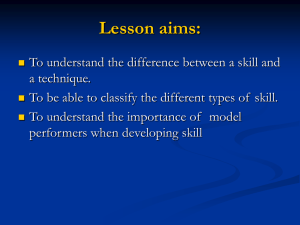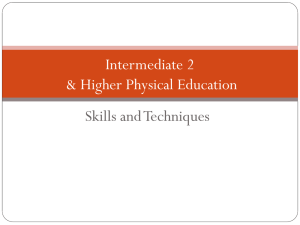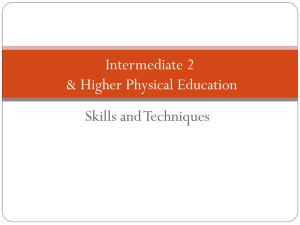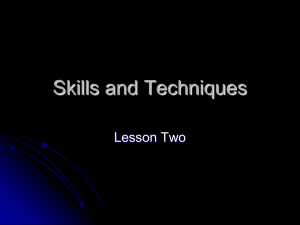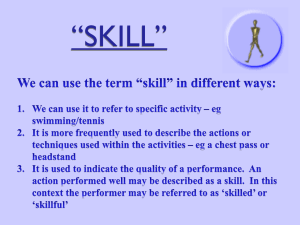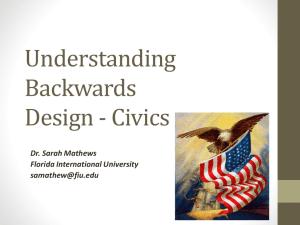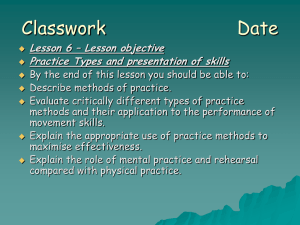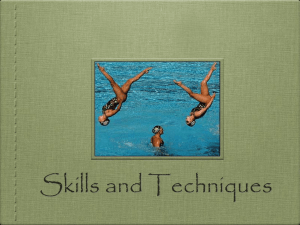PE AS revision guide
advertisement
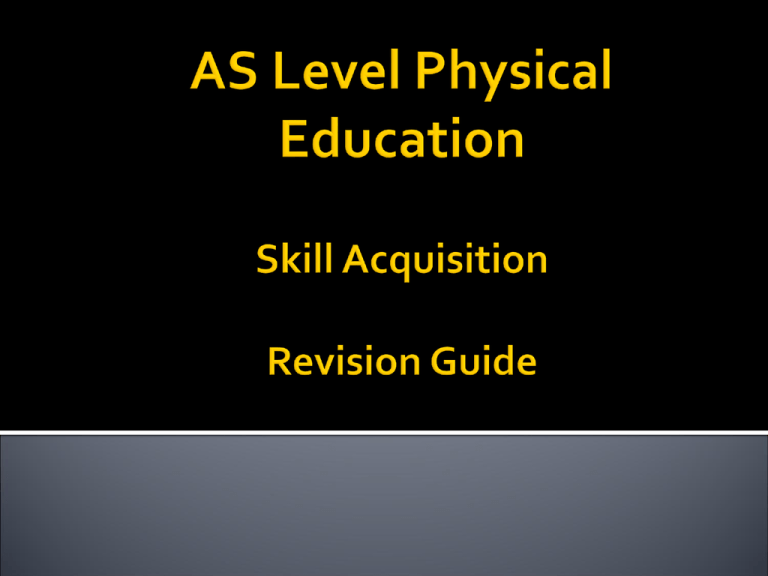
‘Abilities are enduring characteristics which underline a persons potential to acquire skill in one sport or another’ • Ability is something you are born with, it is innate. • Abilities are enduring (long-lasting) characteristics which underlie a person's potential to acquire skill in one sport or another. • To be skilful in one particular sport requires the person to have a specific profile of abilities. ▪ perceptual ability - the ability to detect and use different types of stimuli ▪ conceptual ability - the ability to think through skills quickly ▪ gross abilities - the ability to move the larger parts of the body quickly ▪ fine abilities - the ability to perform delicate movements ▪ kinaesthetic ability - the ability to detect the positions of your limbs in space Finger dexterity Response orientation Reaction time Manual dexterity Response integration Speed of movement Those that involve processing information and implementing movement Static Strength Dynamic Strength Stamina Explosive Strength Dynamaic Flexibility Trunk Strength Those that involve movement and often linked to fitness "The learned ability to bring about predetermined results with maximum certainty, often with the minimum outlay of time or energy or both.“ Knapp Learned Aesthetic Recognisable Goal Directed Characteristics of skill Fluent Consistent Economic Efficient What perceptual skills does the player on the ball need to be successful? “ Skill is an organised, coordinated activity in relation to an object or situation which involves a whole chain of sensory, central and motor mechanisms” Welford • Cognitive – skills that involve thought process and intellectual ability. What to do, which action to use and when! • Perceptual – Skills that involve selecting, interpreting and making sense of information from our senses. • Psych-motor – movement decided upon and controlled by the brain. Mixture of motor and perceptual. Open skills Closed skills Unpredictable environment Predictable environment Decisions to be made No decisions - same skill Selfpaced skills Externallypaced skills Performer decides when to start Start determined by outside agency Performer decides speed of movements Speed of movement decided by others Discrete skills Distinct beginning and end Serial skills Series of discrete skills Continuous skills Repetitive - no beginning and end Gross skills Uses large muscle groups Fine skills Uses small muscle groups A simplified model Input – stimuli to sense organs Decide – what stimuli mean and what to do Output – motor programme runs muscles Stimulus identification stage Decide what information represents Response selection stage Decide on an appropriate response Response programming stage Decide how to organise response Sense organs Stimulus identification Response selection Response programming Muscles movement Memory Senses Stimulus identification Response selection Feedback Response programming Movement 43 main senses involved in sport Eyes/vision/visual sense Ears/hearing/auditory sense Touch/proprioception Body awareness / kinaesthetic sense Three components/stages Detection Comparison Recognition Idea of single channel hypothesis Short-term sensory storage Short-term memory Long-term memory STSS – lasts 0.5-1 seconds; requires immediate attention or is lost STM – only attended information; limited capacity and duration; DCR occurs in STM; rehearsed information goes to LTM LTM – unlimited capacity; requires rehearsal, meaningfulness, speed of learning and overlearning to be remembered/retrieved Long-term memory Short-term memory Sense organs Stimulus Perception Feedback Decision Movement (a) A basic information processing system consists of perception, translation and effector control. Explain what you understand by these terms, using appropriate examples from volleyball. (6 marks) (b) Selective attention is an important part of information processing. How can a coach improve a player’s selective attention? (3 marks) Perception – make sense of incoming information; e.g the ball has left the opposition server’s hand/equiv; Translation – decision making; E.g. the ball is at chest height I will use a set/volley/equiv; Effector control – motor programme/doing the movement; Send impulses to the muscular system in order for the movement to be carried out; E.g hands high/viewfinder/extend the legs. (1 mark for description and 1 mark for appropriate example) (d) Increase intensity of the stimulus/e.g’s; Motivate and arouse the performer; Highlight/ focus cues; Learn to ignore irrelevant stimulus; Response time Time taken from initiation of signal to completion of movement Movement time Time taken from start of movement to completion of movement Reaction time Time taken from initiation of signal to beginning of movement Simple – single stimulus or single response Choice – several stimuli or responses to be selected from Hick’s Law – more choices more time needed to decide Avoid repeating movements/same response – becomes SRT for opponent – easy to react to Choice RT – provide variety of responses – means opponent has to select from many stimuli Practice – develop as wide a range of actions as possible Unable to respond to second stimulus until first stimulus has been responded to – because of single channel Basis of ‘faking’ or ‘dummying’ Give a signal concerning intended movement, then move another way – opponent responds to first signal before responding to second signal, by which time you are long gone! In team games such as basketball or netball, performers need to make rapid decisions. (i) Give an appropriate example from a team game of simple reaction time and choice reaction time. (2 marks) (ii) The ‘Psychological Refractory Period’ often occurs in team games. Explain, using an example of this from a team game, how and why it occurs. (3 marks) (i) SRT - movement to whistle/equiv; CRT - movements of own players on court and who to pass to/equiv; (ii) The use of a deception/fake/dummy/in a named team game situation/equiv; Only process one item of information at a time/equiv; Response to later information likely to be delayed/equiv; Due to responding to first stimulus. 3 functions Change incorrect response Reinforce correct response Motivate performer Intrinsic Extrinsic Knowledge of results Knowledge of performance Immediate/delayed Concurrent/terminal Sourced from within Sourced from outside Concerning end result of action Concerning movement pattern Before/after completion During/at end of action Swimmers will experience different types of feedback both during and after a performance. (a) Knowledge of results and knowledge of performance are two types of feedback. Explain these two types of feedback. (2 marks) (b) What are the three main benefits of feedback to a swimmer? (3 marks) (c) What are the characteristics of ‘effective feedback’ for a swimmer? (4 marks) (a) KR – outcome of action; KP – information about movement/kinesthesis/feel of movement/intrinsic; (b) Correct errors/improve technique/highlight weaknesses; Reinforcement/illustrate success/highlight strengths; Motivation/self-confidence; (c) Process only limited amount of information/succinct/short; Clear information/accurate/correct/relevant/simple; Immediate; Individualised; Different forms – verbal and visual; Intrinsic; Terminal better for beginners/concurrent for elite; Positive for beginners/Negative for advanced; Executive Effector (decides) (does it) No feedback. Pre-planned actions. Explains fast, ‘ballistic’ movements Stored as executive programmes that simply run and cannot be adjusted Motor command Executive Effector Feedback Feedback involved. ‘Memory trace’ recalls previous correct responses and initiates movement ‘Perceptual trace’ as a model of correctness that is adjusted and strengthened through practice. Does not account for actions too fast for feedback Does not explain limits of memory Four relationships (schema) stored for every movement. 1. 2. 3. 4. Initial conditions General motor programme Knowledge of results Sensory consequences Recall schema provides motor programme – 1 and 2 Recognition schema evaluates responses – 3 and 4 (a) In relation to skilled performance, what do you understand by the terms motor programme and subroutines? Give appropriate examples from a tennis serve. (3 marks) (b) Schmidt’s schema theory is based on four sources of information which are used to modify motor programmes. List the four sources of information. (4 marks) (c) How can a coach organise practices to enable a schema to develop? (3 marks) (a) Motor programme – Controls movement/set of instructions/made up of subroutines/plan of action stored in memory (long term)/equiv; Subroutines – Sequences of movement, which are performed automatically/isolated aspects of a movement/practised in parts/equiv; Grip/footwork/backward swing/forward swing/ball toss/contact with ball/follow through; (minimum of three examples for 1 mark) (b) (Knowledge of) initial conditions/set up/requirement of skills; (Knowledge of) response specifications/demands/what is needed; Sensory consequences/Kinesthesis/Knowledge of Performance/KP; Movement outcomes/Knowledge of Results/KR; (c) Practice to be varied/avoid blocked or massed practice/examples; Should include plenty of information; Should have feedback; Should be realistic to the game/activity; Should include transferable elements; Becoming more challenging/more difficult. (c) Practice to be varied/avoid blocked or massed practice/examples; Should include plenty of information; Should have feedback; Should be realistic to the game/activity; Should include transferable elements; Becoming more challenging/more difficult. (c) Practice to be varied/avoid blocked or massed practice/examples; Should include plenty of information; Should have feedback; Should be realistic to the game/activity; Should include transferable elements; Becoming more challenging/more difficult. A relatively permanent change in behaviour Seen to have occurred in performance of skill Improvements in performance seen as a learning curve no improvement Period of rapid improvement little early improvement Learning plateau Performance deteriorates Fatigue Loss of motivation/boredom Technical deficiencies If fatigued – Rest/recovery periods To motivate - Rewards/goals Limited skill - Change style/method of practice or isolate and correct faulty technique The production of a stimulus produces an appropriate response (associationist or S-R theories) Conditioning theories - link between stimulus and response (bond) strengthened by reinforcement Classical and operant conditioning Positive reinforcement is praise Increases probability of repeat of behaviour/success Strengthens S-R bond Negative reinforcement also encourages repeat of success But involves removal of negative/ unpleasant stimulus when desired response occurs - coach/crowd stop barracking Punishment is used to stop repeat of undesired/unsuccessful behaviour/ attempt Inhibits S-R bond strengthening positive reinforcement – the games player makes an accurate pass (behaviour) and the teacher shouts ‘nice pass’ (reinforced) negative reinforcement – the teacher who constantly shouts from the touchline suddenly stops shouting; the players know that their behaviour must now be correct punishment - giving a red card for a foul in a game serves to prevent that behaviour happening again Learn unconditioned response to conditioned stimulus e.g. Pavlov’s dogs Rare in sport Can be used to reduce anxiety prior to performance – relaxation through calming phrase and physical cue Trial and error learning - behaviour reinforced - success/praise motivates to repeat success Thorndike’s laws 1. exercise - rehearse to strengthen bond 2. effect - rewards strengthen bond 3. readiness - performer able to do task Operant conditioning = trial and error learning Based on S-R relationship Coach manipulates environment to achieve desired response (shaping) – target/feeder/conditions/etc Uses reinforcement to bring about desired response Copying/mimicing another's behaviour/action Requires learning to be: Attentive Capable of remembering (retention) Capable of performing (production) Willing to learn (motivation) Insight learning - concerned with understanding rather than linking S-R Work out what is happening - whole practice, rather than learning skills in isolation Cognitive – understanding nature of task; develop motor programme; requires demonstration from coach; feedback is extrinsic; many errors Associative – practice stage; less visual more proprioceptive; fewer but repetitive errors Autonomous – skill mastered; little conscious effort; processing used for strategies rather than skill Positive - benefits Negative - hindrance Bilateral – from one side to other Proactive – current skill helps future skill Retroactive – current skill improves past skill Command Reciprocal Discovery Problem Solving Teacher makes all the decisions with no input from the learners Clear instructions and objectives, large groups catered for, control and discipline maintained Possible lack of understanding, little social interaction, little creativity, limited individual feedback Used when: Groups are large or undisciplined Novice performers need to be taught recognised techniques Dangerous situations Complex skills Most decisions made by teacher with some learner input Instructions and objectives are clear, social interaction skills are developed, some individual feedback received, self-confidence increased May be difficult for beginners, performers may lack communication skills, unable to analyse movement, difficult to monitor for teacher Used when: Learners are more experienced Simple skills are involved Limited danger is present Time is available Teacher guides performer to find the correct movement by providing information, giving specific clues or asking questions Encourages creativity and decision making skills, responsibility for own learning, increased motivation and self confidence Time consuming, difficult for those who lack creativity, progress of large groups is difficult to monitor Used when: Creativity is required There is no right or wrong answer More experienced performers are involved Problem set by teacher and solved by student. There is no right or wrong answer Encourages creativity and develops cognitive skills Novice performer throwing javelin Novice performer developing a gym routine Experienced basketball players practicing free throws in a practice session Sixth from students rock climbing for the first time Year 9 students practicing the smash in badminton, for the first time, in a 50 minute lesson Year 9 students practicing the smash in badminton, for the third lesson in a series or four An outside coach coming in to take a kick boxing lesson at a club for the first time What have you based you decision on? Nature of performer – experience, stage of learning, age, gender, size of group Nature of task – open or closed skill, gross or fine, discrete serial or continuous, self or externally paced Experience – amount of knowledge, personality, relationship with group Environmental conditions – facilities, time available, purpose of the session Whole Learning Part Learning Progressive Part Method Whole-Part-Whole Method Performer attempts the whole movement following instructions or demonstration Develop an awareness of entire movement and understand the relationship between different subroutines immediately Difficult to use with complex skills, difficult for novice performers, not ideal for dangerous skills Ideally used when: Skill is discrete or ballistic Subroutines lack meaning Performer is motivated Performer is experienced Performer attempts all sub routines before attempting skill as a whole Complex skills are broken down into subroutines, specific aspects of technique modified, develops confidence on completion It hinders timing of complete skill, reduces kinaesthetic awareness, transfer part-whole may not be effective, time consuming Ideally used when: The skill is complex Skill involves long sequences Performer has limited attention span Inexperienced Subroutines linked (chaining) once each individual part is learned Complex skills introduced gradually, novice performers achieve quick success, development of understanding of subroutines, transfer to whole is easier Time consuming, too much focus on particular subroutines Ideally used when: Skill is complex, serial or dangerous Time is not a constraint Performer is inexperienced Performer attempts whole skill and then develops specific subroutines before completing the whole skill An overall feel for movement developed initially, success is ongoing as subroutines are developed Transfer form part to whole is difficult A novice athlete learning the triple jump Year 9 class learning how to head a football A premier rugby team learning a set tactical move A golfer practicing his tee shot An experienced fast bowler practicing his action An inexperienced cricketer learning a bowling technique A gymnastics floor routine A year 11 team practicing basketball lay ups A hockey flick An athlete working on their sprint start Mr Kirk learning a dance routine Practice occurs after the presentation of practice Coach to decide on type ensuring learning occurs, motivation is maintained and fatigue does not affect performance Four Types: 1. Massed 2. Distributed 3. Variable 4. Mental Repeated practice with little or no recovery period between blocks 1. 2. 3. 4. 5. Ideally used when: Skills are discrete Performer is motivated Performer is experienced High level of fitness Replication of fatigue in games is required Possible problems – boredom and fatigue Repeated practice followed by recovery period before repetition or new task Recovery period may involve other form of activity not just rest (mental practice or feedback) 1. 2. 3. 4. 5. Ideally used when: The skill is new and complex The performer is a novice Low levels of motivation Low levels of fitness Short attention span Recovery period can lead to – de-motivation, loss of concentration and lack of discipline Coach uses a mixture of massed and variable practice Maintains interest levels and motivation Helps to limit the effects of fatigue when required Cognitive rehearsal of skill without physical movement Used before, during or after performance Internal – sees themselves from within (kinaesthetic feel) External – seeing themselves as if they were a spectator Creates mental image, reduces reaction time, improve anticipation and control arousal 1. 2. 3. 4. 5. 1. 2. 3. 4. Ideally used when: Learning time needs to be reduced Preparing for alternative situations or experiences Concentrate on specific aspects or the overall skill Arousal needs to be controlled Performer is injured Optimised by Quiet Location Encouraging successful outcomes Regular practice Use during recovery period Guidance is used to develop movement patterns and reduce errors made in performance Guidance depends on the situation, nature of the task and ability of performer Types: Visual, Verbal, Manual and Mechanical Creating a mental picture through observation of demos, videos, pictures etc Can also be developed through modifying the playing area To optimise visual guidance: accurate demo, focus on key points, info relevant to age and ability and clear and realistic stimuli Advantages Disadvantages Good for performers in the cognitive stage of learning De-motivation if the performer is unable to replicate the skill Provides a clear idea of the movement pattern to be performed Can provide too much information for a novice Specific cues can be highlighted Static forms of guidance soon loose their impact Explaining the motor skill to be performed, understanding the requirements and feedback General or specific depending on ability To optimise visual guidance: clear and accurate info, limit the amount of information required, language and terminology relevant to age group, most effective with visual guidance Advantages Disadvantages Good for all stages of learning if combined with other types of guidance De-motivation if unable to replicate the skill Useful in the autonomous stage of learning Overload of information may occur Feedback can be given immediately either during or after the performance Difficulty in understanding, especially for novice performers Focus the performers attention on specific cues when watching a demo Some movement may be difficult to explain Involves the performer being physically placed or supported into correct position To optimise manual guidance: avoid over use of kinaesthetic awareness will not develop, combine with verbal guidance and ensure movement pattern is correct Advantages Disadvantages Good for all stages of learning especially novice Performer becomes over reliant on help and support Reduce fear and builds confidence Lack of intrinsic feedback Helps to reduce risks in some potentially dangerous situations Difficult to learn for own mistakes and correct them independently Development of correct kinaesthetic awareness Difficult in large groups Similar to manual but uses some form of device or support Trampolining and swimming use them
